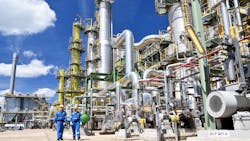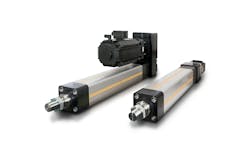Actuator options for process automation from the discrete automation world
Actuators do the heavy lifting in automated processes for liquids and gases as well as discrete motion control. Among the two different types of applications — process and discrete — many of the terminologies and base technologies are the same. However, the application and evolution of those base technologies in the different types of applications are different. It is surprising how little the two worlds intersect and just how difficult it is for specialists from the two worlds to communicate. The words are the same, but the meanings are often just different enough to confuse the conversation. There are opportunities for crossover, taking advantage of the strengths of one for the applications of the other.
The process industries have control valves with actuators designed to open, close and control them. Many prefer pneumatic actuators given their long history, reliability and high performance. Where an air supply is not available or realistic for pneumatic actuators, an electromechanical actuator is an option. However, those tend to not perform as well as the pneumatic options because they are known for either operating much slower than pneumatics, or over-shooting. Many electromechanical actuators also degrade in performance over time as their gearing wears. They typically use little motors and a significant amount of gearing to reduce cost and package size, unless one specifies the top tier models that are usually significantly more expensive. There are also electro-hydraulic options, which tend to be bulkier, require higher maintenance efforts and are much more expensive but offer high torques/thrusts and excellent performance.
Interestingly, in the discrete automation world — a precision motion control world of robotics and pick-and-place gantries — the technological evolution and expectations are much different. Pneumatics are the least expensive option with the lowest expected performance. Hydraulics have their place because of their extremely high force-to-package-size ratio. However, both are fraught with their various leak, maintenance and performance limitations, causing people to often want to go “all electric” if they can. In this world, if you want high performance and low maintenance, electromechanical is high on the list of options.
Circling back to the process industries, if the typical available solutions do not meet a given application’s performance requirements, it is important not to let experience bias prevent you from using solutions from a different world. If that valve’s pneumatic actuator’s ¼%-½% accuracy is not good enough, then an electromechanical solution from the world of discrete automation may be the answer. A ¼% accuracy on a valve actuator with a 200 mm stroke works out to an accuracy of +/- 1 mm. This is a very easy target for precision motion control products where +/-0.05 mm is a typical performance specification.
Or, perhaps you want to be able to control the speed of a valve’s closing or opening better — perhaps slower, faster or some combination of speeds. In this case, the motion control capability of a servo-controlled electromechanical actuator from the discrete automation world is ideal. In this world, motion profiles are defined by accelerations, decelerations, peak velocities and transitions between different velocities. These actuators could close or open a valve quickly enough to cause a problem in the application. However, this is all programmable in software, putting the power in the hands of the person setting it up.
Process systems usually use 4-20 mA analog or hybrid HART/4-20 mA control signals. 0-10 vdc is more typical of either HVAC or commercial systems, or manufacturing floor controllers. Some newer systems use fieldbuses like Foundation Fieldbus or Profibus. If the control system uses an Industrial DCS, there is usually a gateway to typical PLC protocols like Modbus or DeviceNet available. Serial interfaces are rare.
Existing electromechanical valve actuators are typically controlled by analog signals, 0-10 vdc or 4-20 mA, from a control system. These same signals can be used to control electromechanical servo-motor actuators. However, 4-20 mA is a much less common signal interface than the 0-10 vdc option. Analog signals also tend to drive up the cost of these controllers because of the analog-to-digital chips and the more sophisticated controllers required to handle them. There are options available that are more cost effective, easier to use and probably higher performing. These can vary from bus-based interfaces like Profibus, DeviceNet and EtherCAT to serial-based ones with RS232 or RS485 to typical motion control signals like step and direction. The motion can even be preprogrammed for move profiles or positions and simply triggered with discrete inputs. This could be something like Input #1 sends it to 10% closed, Input #2 goes to 20% closed, etc. However, it is important to understand that these options are more difficult to retrofit into an existing system controlling typical valve actuators.
There are not just linear electromechanical actuators that are controlled by servo motors. They can be rotary as well. Even simpler, though, is just using a rotary servo motor as a rotary actuator for something like a ball valve. The rotary servo motor would not need a mechanical actuator and would be coupled directly to the stem of the rotary valve. To some, the motor would then be the actuator. In the discrete automation world, a “motor” and an “actuator” denote two different components of the system. As mentioned, the words and technologies may be the same, but the meanings and connotations may differ.
What applications would benefit from electromechanical servo-motor controlled actuators? Any application where the customer would receive financial benefits from higher performance. These benefits could be higher accuracy, better repeatability, more controlled motion or lower maintenance that result in an improved bottom-line performance. These are probably going to be critical applications needing tight control with expensive ingredients — like the chemical industry with its liquid pressure and pH control applications. Flow control applications may also experience huge benefits. There are even refiners that found the higher performing solutions so critical to their applications that they purchased full sets of spares, so they never would be without a working system.
Specifying the right solution
Trial-and-error is a common method for product selection in some industries — i.e., try an actuator and if it does not work, try a larger one. In the discrete automation industry, trial-and-error is not an effective method due to the cost and lead times of these high-precision products. Proper sizing and selection is the preferred method, but this can mean digging up or guessing at information that is not readily available. An alternative, of course, is grossly oversizing the solution, but this makes it more expensive than otherwise needed.
Most valves have seating or unseating loads that are higher than the load of actually moving the valve. The discrete automation world may refer to this as “stiction,” a non-technical term referring to sticky friction. which is the force required to break the mechanics free of a static location with no motion at all. This unseating load could be covered under a servo motor’s “peak” torque range, while the torque to otherwise move the valve could be covered under the same servo motor’s “continuous” torque range. Since globe valves typically require a “seat load” to meet the shutoff standards required, the servo motor would need to be properly sized to hold that specific thrust level indefinitely. A brake can also be easily used on the motor to hold that position, which could potentially reduce the needed size of the motor. It certainly would reduce the power consumption of the motor and its controls.
Environmental considerations
Valve actuators are often protected in housings, sealing them against the outdoor conditions. Servo motors can be, and are, designed for harsh conditions ranging from washdown IP65 to cryogenic and submersive conditions. But these are special conditions and need to be specified, so do not make any assumptions. The right housing with the right connectors with the right feedback device on the servo motor will meet most of these requirements.
Manual overrides
Another easy assumption to make would be that electromechanical servo motor-controlled actuators will include manual overrides. This is certainly possible but is not the default design of these actuators. Manual overrides are so commonplace on valve actuators that most assume they will be included with any actuator. The solution is simple with an extended shaft on the back of the motor with a hand-wheel mounted to it. It is just not commonly used in the discrete automation world, so make sure you specify it if you need it.
One can always shotgun an approach and try a solution. Perhaps this will save time, and therefore money, if guessed correctly. Alternatively, one can take the time to do it correctly and be sure to take all the requirements into consideration. After all, there are many options and points one must consider to improve their company’s bottom-line.
Corey Foster is an application engineering manager for Valin Corporation, a leading technical solutions provider for the technology, energy, life sciences, natural resources and transportation industries.
Peter Jessee, P.E., is a process application engineer for Valin Corporation. Valin offers personalized order management, on-site field support, comprehensive training and applied expert engineering services utilizing automation, fluid management, precision measurement, process heating and filtration products.
About the Author
Peter Jessee
Peter Jessee, P.E., is a process control application engineer for Valin Corporation, a leading technical solutions provider for the technology, energy, life sciences, natural resources and transportation industries. Valin offers personalized order management, on-site field support, comprehensive training and applied expert engineering services utilizing automation, fluid management, precision measurement, process heating, and filtration products.
Corey Foster
Corey Foster is an application engineering manager for Valin Corporation, a leading technical solutions provider for the technology, energy, life sciences, natural resources and transportation industries.

